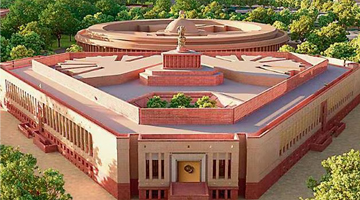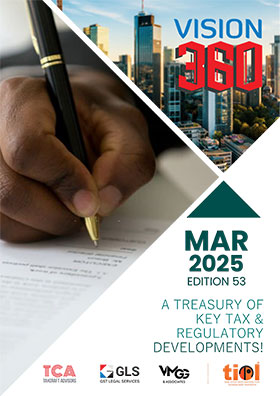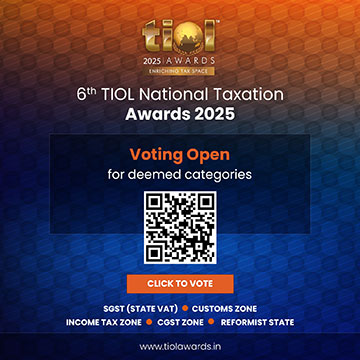Efficacious Disposal of Legacy Tax Disputes: A Key Challenge
JULY 08, 2019
By Lalitendra Gulani & Pallav Palit
"A few mounds of rice from paddy that is harvested from a small piece of land would suffice for an elephant. But what if the elephant itself enters the field and starts eating? What it eats would be far lesser than what it would trample over"
- Pisirandaiyaar to King Pandian Arivudai Nambi
 SHRIMATI Nirmala Sitaraman, India's second woman finance minister, presented her maiden budget on July 5, 2019 under Prime Minister Modi's second term. The Budget 2.0 of 2019-20 is resplendent with various laudable provisions aimed at bringing certainty to points of dispute, rationalization of tax rates, minimization of personal interaction with tax authorities, automation and simplification of compliances and promotion of manufacture in India as against mere import. The Finance (No. 2) Bill, 2019 ('Finance Bill') inter alia contains Sabka Vishwas (Legacy Dispute Resolution) Scheme, 2019 providing for liquidation of tax disputes pertaining to central excise and service tax law. In this article, the author wishes to briefly highlight key features of Scheme and underlying rationale behind its introduction.
SHRIMATI Nirmala Sitaraman, India's second woman finance minister, presented her maiden budget on July 5, 2019 under Prime Minister Modi's second term. The Budget 2.0 of 2019-20 is resplendent with various laudable provisions aimed at bringing certainty to points of dispute, rationalization of tax rates, minimization of personal interaction with tax authorities, automation and simplification of compliances and promotion of manufacture in India as against mere import. The Finance (No. 2) Bill, 2019 ('Finance Bill') inter alia contains Sabka Vishwas (Legacy Dispute Resolution) Scheme, 2019 providing for liquidation of tax disputes pertaining to central excise and service tax law. In this article, the author wishes to briefly highlight key features of Scheme and underlying rationale behind its introduction.
The underlying rationale behind the Scheme
The indirect tax regime witnessed a tectonic shift with the advent of goods and services tax ('GST') law subsuming the erstwhile multiple tax structure. While the litigation under GST is about to commence in full swing, the end of matters pertaining to erstwhile regime pending before various forums does not seem near. The Economic Survey dived into pendency in tax litigation for the first time only in 2017-18. The data revealed that claims (both direct and indirect taxes) for Rs.7.58 lakh crores, which translates to over 4.7 per cent of the Gross Domestic Product, were stuck in litigation at the level of Tribunal and upwards. The overzealous tax authorities had issued show cause notices and preferred appeals in some of the most trivial cases. For e.g., despite the absence of consideration, demand of service tax was raised in matters pertaining to corporate guarantee. In cases where the issue was finally held in favour of assessee, the tax laws were retrospectively amended. Subsequently, the defects in these retrospective legislations led to further litigation. Lord Shaw commenting upon litigation in tax matters in the case of Hoystead v. Commissioner of Taxation 1926 AC 155, observed that litigation would have no end, except when legal ingenuity is exhausted. The Economic Survey further revealed that monies spent by government to recover the tax amount in many cases is uncomfortably higher than the tax claim itself.
While the government's efforts to avoid litigation through timely issuance of clarifications and increase in monetary limits are commendable, there are still miles to walk before satisfactory levels of disposal are achieved. On the indirect tax front alone, as of March 31, 2019, a total of 1.45 lakh appeals for a staggering claim of Rs.3.75 lakh crores are still pending before various forums. The Directorate General of Goods and Services Tax Intelligence in fact, has recently issued show cause notices to over a thousand assessees engaged in automobile sector and oil marketing companies proposing to raise demand of excise duty and service tax. The vanquished investor sentiment heralded by this uncertainty in tax laws has also been pointed in the Economic Survey 2018-19. Anyone who has witnessed the process, knows the challenges and costs it leads to.
Overview of the Scheme
The Scheme proposed in Chapter V of the Finance Bill provides an alternative remedy to the aggrieved assessees to settle their excise and service tax demands in lieu of payment of specified amount. The salient features of the Scheme are as under:
- Coverage: The Scheme covers excise duty, service tax and a host of erstwhile cesses, such as education cess, and secondary and higher education cess. It covers tax dues locked up in litigation pending before any forum or tax dues quantified pursuant an investigation or audit pending as on June 30, 2019. It further covers tax dues confirmed by an order and where no appeal is preferred by assessee, and voluntary disclosures by assessees of their tax dues. However, cases where the appeal preferred or show cause notice has been finally heard or where the issue pertains with refund have been specifically excluded.
- Computation of tax dues and tax relief: The Scheme requires an assessee interested in availing benefit to first compute its tax dues. A specified percentage of the tax dues is eligible as tax relief. The manner of computation of the above amounts are tabulated as under:
|
Scenario
|
Tax dues
|
Tax relief
|
|
Tax dues upto Rs.50 lakh
|
Tax dues greater than Rs.50 lakh
|
| Where an assessee has preferred an appeal |
Duty or tax amount disputed the appeal |
70% of tax dues |
50% of tax dues |
| Where both, the assessee and the revenue, have preferred appeals against same order |
The aggregate of duty or tax amount disputed in appeals filed by assessee and revenue |
| Where the revenue has issued show cause notice |
Duty or tax amount stated in the show cause notice |
| Where an enquiry, investigation or audit is pending |
Duty or tax quantified during the course of such proceeding |
| Where show cause notice is for late fee or penalty, and the duty or tax amount is nil or has been paid in full |
N.A. |
100% of the late fee and penalty |
| Where the assessee voluntarily discloses its duty or tax liability |
Duty or tax amount so disclosed |
No relief |
| Where the duty or tax amount confirmed by an order has |
Duty or tax amount so confirmed |
60% of tax dues |
40% of tax dues |
- Computation of tax payable: The tax payable refers to an amount obtained by deducting tax relief granted under the Scheme from tax dues. The amount paid as pre-deposit upon filing of appeal or deposit during investigation or enquiry shall be eligible for deduction from tax payable. Where the such deposit exceeds the tax payable, the benefit of refund however will not be admissible.
- Procedure: The Scheme requires the assessee interested in availing the benefit to file a declaration with designated committee specifying its tax dues, tax relief and tax payable. The committee upon receipt of a declaration is obligated to verify the statement, except where the amount is voluntarily declared. Where upon verification, the committee is satisfied with the veracity and exactitude of declaration, it will issue a statement specifying the declared amounts. However, where the committee is not satisfied, it shall issue an estimate of the tax dues. The committee, after allowing an opportunity to be heard, shall issue a statement indicating tax dues and tax payable within 60 days of declaration. The assessees are required to deposit the stipulated amount within 30 days of receipt of such statement, withdraw the reply or appeal and furnish proof of the same to the committee. The committee shall accordingly issue a discharge certificate within 30 days of the production of proof.
- Restriction: The Scheme restricts the assessee from discharging the tax payable using input tax credit amount. Further, tax amount paid is not available as credit to the recipient.
- Immunity from interest, penalty and prosecution: The assessee upon receipt of discharge certificate shall be immune from the following:
- The remaining amount of tax dues, interest and penalty with respect to the matter;
- Prosecution under the concerned enactment; and
- Subsequent re-opening of the matter by the revenue in any manner
Conclusion
The Finance Minister in her speech before the start of tax proposals took a leaf from the above quoted prose from Tamil sangam era. In the context addressed, while the elephant in prose refers to tax administration, the paddy field refers to India Inc. The colossal litigation pending right now before various forums owes its existence to the trampling down by tax authorities. The Economic Survey reveals that the success rate of revenue in forums above Appellate Tribunal does not exceed even 20 per cent. In such a scenario, the remedial measure provided by the Scheme is a welcome step, despite its shortcomings such as it fails to cover additional duties of customs imposed under Customs Tariff Act, 1975. The author prays that the smooth operation of the Scheme will wins the 'Vishwas' of investors. But more importantly, the author and the industry today sincerely hope that GST regime will be smoother and for most part free from litigation. For this, the tax authorities will have to align their actions with the advice by Kautilya in its Arthashastra, wherein he likened the tax authorities collecting taxes to a bee collecting the nectar from flowers only in perfect measure.
(The authors are Partners at Palit & Co., Advocates and Solicitors and the views expressed are strictly personal.)
| (DISCLAIMER : The views expressed are strictly of the author and Taxindiaonline.com doesn't necessarily subscribe to the same. Taxindiaonline.com Pvt. Ltd. is not responsible or liable for any loss or damage caused to anyone due to any interpretation, error, omission in the articles being hosted on the site) |









 SHRIMATI Nirmala Sitaraman, India's second woman finance minister, presented her maiden budget on July 5, 2019 under Prime Minister Modi's second term. The Budget 2.0 of 2019-20 is resplendent with various laudable provisions aimed at bringing certainty to points of dispute, rationalization of tax rates, minimization of personal interaction with tax authorities, automation and simplification of compliances and promotion of manufacture in India as against mere import. The Finance (No. 2) Bill, 2019 ('Finance Bill') inter alia contains Sabka Vishwas (Legacy Dispute Resolution) Scheme, 2019 providing for liquidation of tax disputes pertaining to central excise and service tax law. In this article, the author wishes to briefly highlight key features of Scheme and underlying rationale behind its introduction.
SHRIMATI Nirmala Sitaraman, India's second woman finance minister, presented her maiden budget on July 5, 2019 under Prime Minister Modi's second term. The Budget 2.0 of 2019-20 is resplendent with various laudable provisions aimed at bringing certainty to points of dispute, rationalization of tax rates, minimization of personal interaction with tax authorities, automation and simplification of compliances and promotion of manufacture in India as against mere import. The Finance (No. 2) Bill, 2019 ('Finance Bill') inter alia contains Sabka Vishwas (Legacy Dispute Resolution) Scheme, 2019 providing for liquidation of tax disputes pertaining to central excise and service tax law. In this article, the author wishes to briefly highlight key features of Scheme and underlying rationale behind its introduction. 





